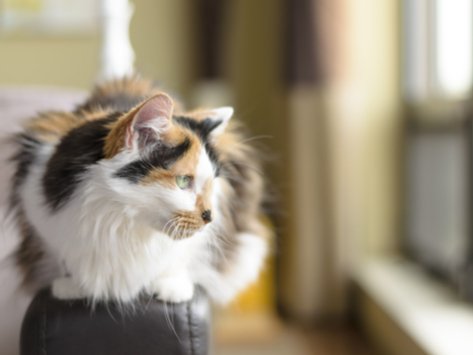Declawing Can Result in Long-Term Problems for Cats

As a licensed veterinary technician, I have seen the side effects of declawing cats—and they’re not pretty. Declawing, or onychectomy, is a severe surgical procedure in which the last bone of each toe (the third phalanx) is amputated.
Many cats who have been declawed refuse to use the litter box over time, because the process is extremely painful. Following surgery, cats are often deterred from the natural process of scratching in the litter box. So, they tend to find soft, less painful options, like carpets, piles of laundry, and even your bed or pillows.
There are other short- and long-term effects of this procedure. As with any surgical operation, there may be anesthetic complications, hemorrhage, infection, and pain. Sometimes, if the bone is not removed in its entirety, the cat may traumatize himself chewing or gnawing at the affected area.
Additional procedures may be necessary to remove more of the bones or repair the damage. This means more anesthesia, and more risk of going back under the knife for an elective procedure. Removing the bone of the digit also changes the cat’s anatomy, how he bears weight on his paws, and his entire posture. Declawing may also increase a cat’s risk of developing long-term back pain, a recent study found.
More than 25 countries around the world have outlawed cat declawing, and many states are lobbying for this as well. It’s illegal in several California cities, including Los Angeles and San Francisco. In January 2015, Manhattan Assemblywoman Linda Rosenthal introduced a bill that would make New York the first state to ban cat declawing altogether, but no vote has been scheduled. A similar bill passed the state Assembly in New Jersey in January 2017.
Scratching Is a Normal Feline Behavior
In many cases, pet owners elect to declaw their cats to stop them from destroying furniture or injuring other household animals or family members.
Of course, there are also medical reasons that may call for a cat to be declawed, such as damage to the nail, a tumor, or irreversible trauma. With ill-behaved, somewhat feral cats, declawing may be considered if there is a threat of hurting a child, or if the owner has a bleeding disorder and the risk of injury is too high.
Otherwise, people tend to opt for this procedure because they want to maintain the integrity of their leather couch, or they don't want their carpets ruined. But the fact of the matter is, declawing may not stop these incidents from happening. Usually, only the front claws are removed, and the back claws can still puncture material.
Scratching is a normal behavior for cats. It helps them mark their territory with scent glands located in their paws, keeps their claws conditioned, and stretches their muscles. To avoid surgery, you can use training methods to redirect your cat’s scratching.
Purchase a few scratching posts, planks of wood, or cardboard boxes for your cat to scratch instead of the side of the couch. To encourage your cat to use these new scratching items, you can try sprinkling catnip on them. Remember to praise him whenever he scratches acceptable items. If you see him scratching inappropriate items, redirect his behavior to the correct item. You can also use deterrent sprays where you don’t want him to scratch.
Be sure to keep your cat’s claws trimmed regularly, about once every two weeks. You should also discuss other options with your veterinarian, such as behavioral modification medications. There are many alternatives to the short- and long-term negative effects of declawing, all of which should be explored before surgery.
Information is a crucial part of this decision for you and your cat. Be sure to research all possibilities before surgery becomes the last resort. Your veterinarian will be a valuable resource, and can help you make the best choice for you and your beloved feline companion.
Natasha Feduik is a licensed veterinary technician with Garden City Park Animal Hospital in New York, where she has been practicing for 10 years. Natasha received her degree in veterinary technology from Purdue University. Natasha has two dogs, a cat, and three birds at home and is passionate about helping people take the best possible care of their animal companions.